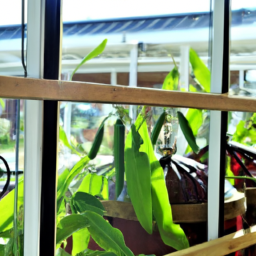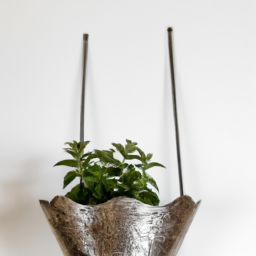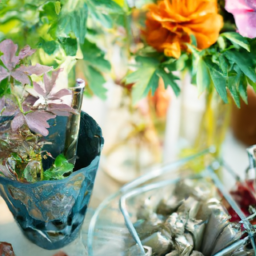
Are you tired of living in a small space and feeling like you can’t have a garden? Well, fear not! Container garden magic is here to save the day and help you maximize your small spaces. Whether you live in an apartment with a tiny balcony or have a small backyard, container gardening offers a fantastic solution to bring nature into your surroundings. In this blog post, we will explore the wonders of container garden magic and discover how you can create a lush and thriving garden in even the tiniest of spaces. So, grab your gardening gloves and let’s dive into the world of maximizing small spaces with container garden magic!
h2 {
font-size: 24px;
font-weight: bold;
margin-bottom: 10px;
}
h3 {
font-size: 20px;
font-weight: bold;
margin-bottom: 5px;
}
p {
font-size: 16px;
margin-bottom: 10px;
}
Benefits of Container Gardening in Small Spaces
Gardening is a delightful hobby that brings joy, beauty, and a sense of accomplishment to many people. However, not everyone has access to a large yard or garden space. This is where container gardening comes to the rescue! Container gardening is a magical way to maximize small spaces and enjoy the wonders of nature right at your doorstep. In this article, we will explore the numerous benefits of container gardening and provide you with a step-by-step guide to create your very own container garden.
Enhancing Aesthetics
One of the greatest benefits of container gardening is the ability to enhance the aesthetics of any small space. Whether you have a balcony, a tiny patio, or even just a windowsill, you can transform it into a lush oasis with the right selection of plants and containers. By carefully choosing plants with varying heights, colors, and textures, you can create a visually stunning display that will impress both yourself and your guests.
Consider using tall, upright plants like ornamental grasses or dwarf trees as the focal point of your container garden. Surround them with trailing plants like ivy or cascading flowers such as petunias to add depth and drama. Don’t forget to include some medium-sized plants to fill in the gaps and create a balanced composition.
Additionally, containers themselves can be chosen to complement your existing outdoor decor. From traditional terracotta pots to modern fiberglass planters, there is a wide variety of options available to suit any style preference. Get creative and experiment with different shapes, sizes, and materials to add a touch of personal flair to your container garden.
Flexibility and Mobility
Another advantage of container gardening is the flexibility and mobility it offers. Unlike traditional gardening, where plants are rooted in the ground, container gardens can be easily rearranged and relocated as needed. This is particularly beneficial for those living in rental properties or individuals who frequently move.
With container gardening, you can easily experiment with different layouts and designs. If you find that a particular plant isn’t thriving in its current location, simply move it to a more suitable spot. You can also rearrange your containers to create new focal points or change the overall look of your space. This flexibility allows you to adapt your garden to the changing seasons, sunlight patterns, or even your own mood and preferences.
In addition to being flexible, container gardens are also portable. If you’re moving to a new home, you can take your beloved plants with you, ensuring that you don’t have to leave behind years of hard work and cherished memories. This mobility is especially valuable for individuals who have invested time and effort into cultivating rare or sentimental plants.
Accessibility and Convenience
Container gardening offers a high level of accessibility and convenience, making it an ideal option for individuals with physical limitations or busy lifestyles. By bringing the garden to you, container gardening eliminates the need for bending, kneeling, or excessive physical exertion often associated with traditional gardening.
With container gardens, you can place your plants at a height that is comfortable for you, whether it’s on a raised table, a hanging basket, or even a vertical wall planter. This not only reduces strain on your body but also allows you to easily tend to your plants without the need for excessive bending or reaching.
Furthermore, container gardens require less maintenance compared to traditional gardens. The confined space of containers naturally limits the growth of weeds, reducing the need for frequent weeding. Additionally, container plants are less susceptible to certain pests and diseases that commonly affect plants grown in the ground. This means less time spent on pest control and more time enjoying the beauty of your garden.
In conclusion, container gardening is a magical way to maximize small spaces and enjoy the benefits of gardening, even without a large yard. By enhancing aesthetics, providing flexibility and mobility, and offering accessibility and convenience, container gardens bring the joy of nature right to your doorstep. So, why wait? Grab your favorite plants, choose some beautiful containers, and embark on your own container garden magic today!
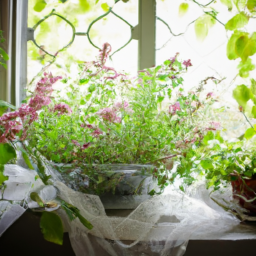
Container Garden Magic: Maximizing Small Spaces
2. Choosing the Right Containers for your Small Space Garden
When it comes to container gardening in small spaces, choosing the right containers is crucial for the success of your garden. The right containers not only provide the necessary space for your plants to grow, but they also add aesthetic appeal to your garden. In this guide, we will walk you through the process of selecting the perfect containers for your small space garden.
Material Selection
One of the first decisions you need to make when choosing containers for your small space garden is the material. There are various options available, each with its own advantages and disadvantages.
Terracotta pots are a popular choice due to their classic look and ability to absorb excess moisture. However, they can be heavy and prone to cracking in freezing temperatures.
Plastic containers are lightweight, affordable, and come in various sizes and colors. They are also durable and retain moisture well. However, they may not provide the same aesthetic appeal as terracotta or ceramic pots.
Ceramic pots are known for their beauty and come in a wide range of designs. They are heavier than plastic containers, but they provide better insulation for the roots. However, they can be expensive and may crack in extreme temperatures.
Size Matters
When selecting containers for your small space garden, size matters. The size of the container should be appropriate for the plants you wish to grow. Larger plants require more space for their roots to grow and spread.
Consider the mature size of the plants and choose containers that can accommodate their growth. If you are growing vegetables or herbs, ensure that the containers are deep enough to support their root systems.
Additionally, consider the available space in your small garden. If you have limited space, opt for smaller containers that can be grouped together to create an attractive display.
Drainage and Watering
Proper drainage is essential for the health of your plants. Ensure that the containers you choose have drainage holes at the bottom to prevent waterlogging. Excess water can lead to root rot and other diseases.
Consider the watering needs of your plants when selecting containers. Some plants require more frequent watering, while others prefer drier conditions. Choose containers that can retain moisture for plants that require more water, and containers that allow for better drainage for plants that prefer drier soil.
Additionally, consider the weight of the containers when filled with soil and water. If you plan to move your containers frequently, opt for lightweight materials that are easier to handle.
Conclusion
Choosing the right containers is a crucial step in maximizing small spaces for container gardening. Consider the material, size, drainage, and watering needs of your plants when making your selection. Remember, the right containers not only provide a suitable environment for your plants to thrive but also add beauty and charm to your small space garden.
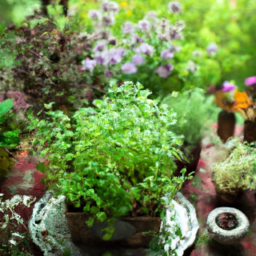
Container Garden Magic: Maximizing Small Spaces
Tips and Tricks for Maximizing Space in a Container Garden
Container gardening is a fantastic way to bring the beauty of plants into small spaces. Whether you have a tiny balcony or a small backyard, you can create a lush and vibrant garden using containers. In this article, we will explore some tips and tricks to maximize space in your container garden and make the most of your limited area.
1. Choose the Right Containers
The first step in maximizing space in your container garden is to choose the right containers. Opt for tall, narrow pots that take up less floor space but provide ample room for plant roots to grow. Hanging baskets and vertical planters are also great options as they utilize vertical space effectively.
Additionally, consider using unconventional containers such as old buckets, wooden crates, or even repurposed furniture. These unique containers not only add charm to your garden but also help you make the most of every available inch.
Remember to ensure that your containers have proper drainage holes to prevent waterlogging, which can be detrimental to plant health.
2. Select Compact and Multi-functional Plants
When space is limited, it is essential to choose plants that are compact and offer multiple benefits. Look for dwarf varieties of your favorite plants, such as cherry tomatoes, peppers, or herbs, as they take up less space while still providing a bountiful harvest.
Consider growing plants that serve multiple purposes, such as edible flowers or herbs that can be used for cooking or making herbal teas. This way, you can maximize both your space and the usefulness of your garden.
Furthermore, opt for plants that have a vertical growth habit, like climbing roses or vine vegetables. These plants can be trained to grow on trellises or fences, saving valuable ground space.
3. Utilize Vertical Space
One of the key strategies for maximizing space in a container garden is to utilize vertical space effectively. Vertical gardening allows you to grow more plants in a smaller area while adding visual interest to your garden.
Install trellises, hanging baskets, or wall-mounted planters to grow trailing or climbing plants. You can also use a ladder or a pallet to create a vertical garden by attaching pots or planters at different heights.
Another clever way to utilize vertical space is by using tiered or stacking planters. These planters have multiple levels, allowing you to grow a variety of plants in a compact footprint.
Remember to consider the weight of your containers and ensure that they are securely attached to prevent accidents or damage to your plants.
In conclusion, maximizing space in a container garden requires careful planning and thoughtful selection of containers and plants. By choosing the right containers, selecting compact and multi-functional plants, and utilizing vertical space effectively, you can create a stunning and productive garden even in the smallest of spaces.
In a Nutshell
If you’re a gardening enthusiast but lack the luxury of a large outdoor space, fear not! Container gardening is here to save the day and make your green dreams come true. With a little creativity and some strategic planning, you can transform even the tiniest balcony or patio into a flourishing oasis.
Container gardening is all about maximizing small spaces and making the most of what you have. The beauty of it lies in its versatility – you can grow a wide variety of plants, from vibrant flowers to delicious herbs and even small vegetables. By carefully selecting the right containers and utilizing vertical space, you can create a magical garden that not only adds beauty to your home but also provides you with fresh produce and a sense of tranquility. So, whether you’re a city dweller or simply have limited outdoor space, container gardening is the perfect solution to bring nature closer to you and make the most of your small oasis.
Q&A Corner:
Q1: How can I maximize small spaces with container gardening?
A1: Container gardening is a fantastic way to make the most of limited space. By using pots, planters, or containers, you can grow a variety of plants in even the smallest of areas. Whether you have a balcony, patio, or just a tiny backyard, container gardening allows you to create a beautiful and productive garden.
Q2: What are the benefits of container gardening in small spaces?
A2: Container gardening offers several advantages for those with limited space. Firstly, it allows you to grow plants vertically, taking advantage of the vertical space available. Secondly, it provides flexibility as you can easily move the containers around to optimize sunlight exposure. Additionally, container gardening requires less maintenance, as you can control the soil quality, watering, and fertilizing more effectively.
Q3: What types of plants are suitable for container gardening in small spaces?
A3: There is a wide range of plants that thrive in containers, making them ideal for small spaces. Herbs like basil, rosemary, and mint are excellent choices, as they don’t require much space and can be easily harvested. Leafy greens such as lettuce, spinach, and kale also do well in containers. Compact vegetables like cherry tomatoes, peppers, and dwarf varieties of beans and cucumbers are great options too. Lastly, flowers like petunias, marigolds, and pansies add color and beauty to your container garden.
Q4: How do I choose the right containers for my small space garden?
A4: When selecting containers for your small space garden, consider a few factors. Opt for lightweight containers that are easy to move around. Ensure the containers have proper drainage holes to prevent waterlogging. Additionally, choose containers that are appropriately sized for the plants you intend to grow. If you have limited floor space, vertical planters or hanging baskets can be a smart choice to maximize your growing area.
Q5: What are some tips for successful container gardening in small spaces?
A5: To ensure success with your container garden in small spaces, here are a few tips:
– Use high-quality potting soil to provide proper nutrients and drainage.
– Water your plants regularly, as container gardens tend to dry out faster.
– Place your containers strategically to optimize sunlight exposure for each plant’s requirements.
– Provide adequate fertilization based on the plant’s needs.
– Prune and trim your plants regularly to maintain their size and shape.
– Keep an eye out for pests and diseases and take appropriate measures to prevent or treat them.
– Lastly, enjoy the process and experiment with different plant combinations to create a magical container garden!
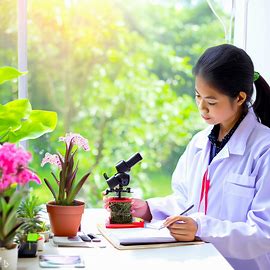
Lisa Chen is a seasoned indoor gardening expert and the author of several bestselling books on the topic. With a background in horticulture and urban farming, Lisa is dedicated to helping urban dwellers embrace the joys of cultivating green spaces indoors. Her detailed guides and hands-on tips empower readers to transform their living spaces into thriving plant sanctuaries.

